Travis P here. Last time we talked about levels of war (tactical, operational, and strategic) and mentioned a number of different types of war (siege, aerial bombing campaigns, etc). This time we’re looking at something called “Spectrum of Conflict.” In my experience working with engineers, they like diagrams and images. Travis Chapman is no exception, established by the fact he’s provided three diagrams of the concept we’re discussing! To which I’m actually adding one image I found on my own, the first one below, because I feel it gets across well why the word “spectrum” gets used for this military topic (from Heritage.org):
Just like a spectrum of light has a variety of shades of color, warfare can come across as a spectrum of activities that nations can perform, just like the diagram I just used shows. To make sure everyone understands the concept, let me use the Cold War as an example:
The United States and the Soviet Union, for approximately forty-five years, assumed roles as global adversaries. The two nations each had a section of divided Berlin, each had masses of troops in its own version of Germany (and Korea, though that also involved the Chinese). Each had strategic nuclear weapons capable of killing the majority of the human race, competing with one another as to who would have the most such weapons. Each had a global navy and an active competition in outer space; each extensively spied on one another; each supported revolutions in other nations (often with covert action); and each engaged in smaller wars on the periphery of areas they controlled, with the other side supporting the opposition–in Vietnam and Afghanistan in particular. The closest they ever got to direct war was when Soviet “advisors” to the North Koreans were actually flying MIG jets that US pilots (in South Korea under a United Nations mandate) engaged in aerial combat.
Most Cold War war activities would be in the “gray zone” of the diagram I’ve shared. Some covert actions would get into the “irregular” zone of covert operations. “Hybrid war” I’ll talk about in a bit…and a “limited conventional war” is what the USA might call our war in Vietnam. No “theater conventional war” (as in, all of Asia, i.e., a theater) happened during the Cold War.
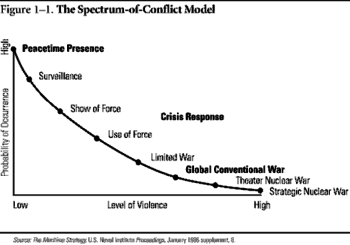 |
The reason this is the case for major modern nations (note the chart tops off at “Strategic Nuclear War”) is because the entire dynamic of national interactions is different when strategic weapons are around, since we really don’t want to blow ourselves up. If we diagrammed Genghis Khan’s spectrum of conflict, it might have only have two points on it–”call on foes to surrender” or “invade.” (Ahem.) Though even though modern nations generally have more options, most nations over most of the world’s history have had a variety of actions they could take against other nations. These include such things as a trade embargo or denial of access to strategic areas (like closing off the Soviet fleet’s access to the Mediterranean in the Cold War).
Let me show another diagram (also from Air University) that helps illustrate how two modern countries have a variety of possible responses to one another. Note the axis of probability on the vertical versus the violence axis on the horizontal, which shows that under modern-day conditions, less violent actions are more likely to be a nation’s first response over more violent ones:
But the two charts I’ve shared so far still don’t fully account for all the possible actions that can be a part of war’s spectrum. Here’s another:
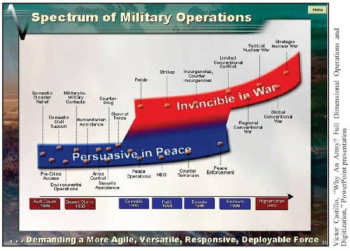 |
| Credit: Victor Castillo, “Why An Army? Full Dimensional Operations and Digitization” from On Point. |
Modern U.S. Army doctrine (“Unified Land Operations,” ADP 3-0) looks at the spectrum of conflict a bit differently. It says all forms of warfare consist of three things, offense, defense, and “stability operations” (which means activities a military performs when not in direct combat to maintain peace). It’s a bit like mentioning a television uses three primary colors in various mixtures to create every shade of color you see. Though whether or not these three colors cover all possibilities is perhaps debatable–for example, the Art of War extensively talks about offense and defense but also mentions peace negotiations as an element of war (Sun Tzu, The Art of War, Ch. 3, 17).
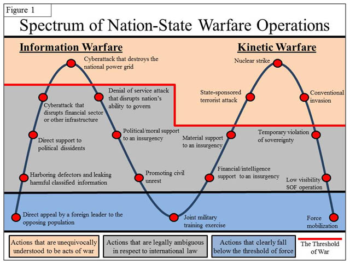 |
| Credit: Jason Rivera at Small Wars Journal |
But let’s look at some of the elements that are very modern on this chart. Like cyberwarfare. Or a nation sponsoring a terrorist attack. These are elements of “hybrid warfare,” which is quite a modern idea. It’s the everything-including-the kitchen-sink approach. Russia has used variations of hybrid warfare against Georgia and Ukraine–they messed with elections, knocked out electric power, crashed key servers with cyberattacks, shut down the airwaves, put military personnel in civilian clothes and had them conduct strikes (that would seem to be terrorist attacks), funded actual insurgents, and followed up with conventional military attacks. In other words, they did as much damage as possible while maintaining plausible deniability of their involvement, which had the effect of increasing the effectiveness of their regular military when they rolled in.
Futuristic science fiction stories should include hybrid warfare as something that nations (or planets) would at least know about, if not perform. But while these ideas are modern and aren’t likely to be going away, let’s not rule out fantasy worlds having their own versions of hybrid warfare. Because story worlds that include the practice of magic could have lots of nasty ways to strike out at an enemy covertly while maintaining plausible deniability. Though of course, not everyone would want to fight a hybrid war, even if they could.
Remember what I said above about Genghis Khan as a bit of joke? (and what’s not funny about a brutal invasion? Hey...just kidding) Where I said he’d have only two possible actions? That example shows that nations are not just shaped by their technology, what they are capable of doing, but by their culture, what they’re interested in doing. And it gives a speculative fiction writer some room to be creative with alien and demi-human or magical races. Aliens or demi-humans etc. might have very different ideas about what is and is not legitimately part of a war (or peace) than humans have–and what methods can be considered “fair game” in war. And obviously if that race even wants to play fair. Which is something worth considering when thinking about your aliens/demi-humans/magical creatures.
Travis C here: Hopefully it’s clear that when you hear “war” it could mean almost anything. If you are an author, you will need to define what you mean and try to stay consistent. If you are a reader, you’re already mentally doing the analysis to figure out “What exactly is going on?” and hoping the author gives you enough detail to draw a conclusion. Even with a sweeping multipart epic like Game of Thrones or The Stormlight Archive, it’s challenging for an author to paint the entire spectrum from peaceful military-to-military training all the way through “No, really, this is the end!” Armageddon-esque battles.
As an example of a spectrum of conflict at work, I’d like to use a softball: J.R.R. Tolkien’s world of Middle Earth. Tolkien’s writings are extensive and provide sufficient material to draw from, but for those who haven’t enjoyed the pleasure of The Silmarillion, I’ll draw from the Peter Jackson envisioned story as told in each trilogy: The Lord of the Rings and The Hobbit (or as I call it, “A Movie About a Book I Once Read Called The Hobbit That I Can’t Remember That Well But Thought Would Be Cool In Three Movies…”) I digress…
Let’s look at the easy side first: Everyone Not Mordor.
 |
| What’s this ranger doing Bree? Peacekeeping operations? (Credit: New Line Cinema) |
Through seemingly miraculous means, the good people of Middle Earth unite against the orcs of Angmar and goblins of the Misty Mountains. Some of these forces are clearly prepared for combat (elves & dwarves), and given their long lives they have experience on their side, so we’ll assume there’s some active training happening in the background. The humans of Lake Town appear disorganized yet motivated to defend their own, having suffered the consequence of fighting against Smaug those many years ago.
Fast forward to The Fellowship of the Ring. We see several former allies acting as nations might during a time of peace that anticipates future conflict. As we leave the Battle of the Five Armies, we have an agitated group of elves all intent on vacating Middle Earth (well, many of them). The dwarves have withdrawn to their strongholds. Yet each of the major kingdoms of men realize conflict is coming.
The most obvious is Gondor. We see evidence that Gondor, more than any other nation, has experienced a progression from the low intensity end of the spectrum. What were initially peacekeeping operations across the river from Osgiliath have now become border defense. Orc raids test the defenses and consume Gondor’s waning resources and attention. Military-to-military ties with Rohan have been broken due to a classic case of “Where were you when…” Lord Faramir’s efforts to hold Osgiliath, and his brother Boromir’s actions before that, have clearly escalated from peacekeeping and surveillance of the enemy to shows of force (i.e., having troops garrisoned at the ford) and limited engagements.
The most obvious is Gondor. We see evidence that Gondor, more than any other nation, has experienced a progression from the low intensity end of the spectrum. What were initially peacekeeping operations across the river from Osgiliath have now become border defense. Orc raids test the defenses and consume Gondor’s waning resources and attention. Military-to-military ties with Rohan have been broken due to a classic case of “Where were you when…” Lord Faramir’s efforts to hold Osgiliath, and his brother Boromir’s actions before that, have clearly escalated from peacekeeping and surveillance of the enemy to shows of force (i.e., having troops garrisoned at the ford) and limited engagements.
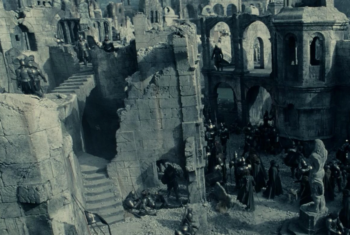 |
| Garrisoned at Osgiliath, Faramir’s efforts to secure the border between Gondor and Mordor have failed. Border security has morphed into a limited war on the Pelennor. (Credit: New Line Cinema) |
We saw a similar situation in The Two Towers, as Rohan’s roving horse warriors, the Rohirrim, react to increasing threats to their borders by orc raids. As Éomer (and his cousin before him) try to press King Theoden to escalate their actions, he is met with resistance and ultimately must chose exile to maintain a semblance of border protection. This quickly progresses to the siege at Helm’s Deep and the quick deployment of Rohan’s army to support Gondor.
Now let’s change places to the less-easy, but beautiful, examples of conflict spectrum provided by Isengard and Mordor.
In The Fellowship of the Ring, we witness the rise of Isengard as Saruman extends his influence and schemes in concert with Mordor. As his tower Orthanc becomes a seat of military power we watch, quite truly, the shaping of Isengard’s forces and resources as Saruman prepares to leave diplomacy and scheming behind and embark upon a conventional war against his enemies. Orc raids, seen in Fellowship, extend into Rohan. Human allies are sought and brought into his armies in what we’d call coalition operations. An information campaign aids Saruman in winning discontented men to his side, and he wields his most effective weapon, Wormtongue, against the only significant threat in the region. Once Theoden is free from his prison, the clock winds down to the Battle of Helm’s Deep and the retaking of Isengard by the Ents.
What we don’t see in The Two Towers is a progressive escalation up to the conventional battle. We know Isengard has been active, but it’s not shown on the screen (and not significantly developed in the book). In my opinion, that’s alright. Tolkien was trying to tell a different story that one of a military escalation of force. Yet, we have seen similar events in our own time, when a nation throws the majority of its eggs in one basket and embarks on a military objective knowing that, if successful, their single credible threat would be eliminated long enough to secure the ultimate purposes of the nation. The risk of failure doesn’t outweigh the value of success. Would that Saruman might have sent his forces elsewhere.
Lastly, we have Mordor. I’d like to go back in time a bit though, and let’s think of how we arrived here. Sauron crafted the Ring and its kin. Nine kings gave their kingdoms and lives in service to Mordor. That’s a powerful alliance. Mordor’s strength, while thrown back in the Battle of Dagorlad (the opening sequence to The Fellowship of the Ring), continued to grow in its protected realm.
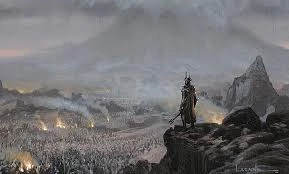 |
| Sauron observing the Battle of Dagorlad from Mordor, an example of a limited war escalating into a theater war against a combined army of allies. (Credit: LOTR Wikia) |
By the time Frodo and Sam enter the picture, we have an active Mordor pressing the borders of Gondor. Sauron’s emissaries have successfully brought Umbar and the Easterlings into alliance. With forces moving in the open, we witness Mordor showing its strength to any who would see.
By The Two Towers we watch Sauron’s campaign against Gondor unfold, going from raids and strikes to a persistent attack against Osgiliath, to the opening movements that signal at least a limited war (taking Osgiliath as a foothold) and ultimately the Battle of Pelennor Fields (Gondor) and later, the Battle of the Morannon (Battle of the Black Gates) when Sauron is overthrown.
Whew.
Hopefully you’ve seen a few examples in the canon of Tolkien to quench our literary thirst. Certainly we could make our analysis even deeper, but space limits us here. Tolkien created a world where war escalated quickly yet contained many elements of a spectrum of conflict. Another example might be Brandon Sanderson’s The Stormlight Archive, where we enter a world already deep into a protracted war, with flashbacks that help the reader understand how it reached that stage, with clear progression of military actions, as well as brilliant examples of hybrid warfare that involves information and public opinion among the participants.
I also hope we’ve piqued your interest in the subject. It was always a favorite of mine in my strategy & war classes. I recommend searching for “spectrum of conflict” to see other examples that may be helpful in how you plan your next book or series with war as a key element. Now back to those X-Y plots and charts I’ve got brewing….

Comments
Post a Comment